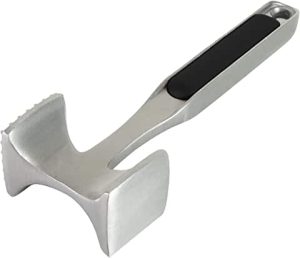You want to know that every meal you make in the kitchen is the finest it can be. It’s not worth taking a chance to not get your meat as soft as it can be.
Many methods of tenderizing meat cuts are available to get the most out of modern cuisine, meals, or snacks. These methods aim to make the meat more tender, moist, and tasty.
Some of the techniques may take more time than others. But they may all greatly improve the results of your roasting, grilling, and other oven-based cooking methods with just a little extra effort.
No products found.
What Is Tenderizing Meat?
This is a method that helps to soften meat by breaking down its connective tissue. Among the many methods available for tenderizing meat are slow cooking, marinating, and pounding.
Marinate
The most common method used to tenderize meat in most homes is marinating. The marinade’s acidic chemicals soften the meat by breaking down the muscle fibers.
The natural meat flavor is often lost when marinating. Hence, many steak lovers avoid doing so. In reality, several seasonings may improve the meat’s flavor. Go easy on the acids and spices when making the marinade.
Make a marinade by combining all the ingredients in a zip bag or bowl and rubbing them into the meat. Now, grab your preferred acidic ingredient to use as a tenderizer. It might be yogurt, lemon juice, or apple cider vinegar. Then, season it with olive oil and the spices of your choice.
The best flavor comes from the combination of garlic powder, onion powder, smoked paprika, and black pepper.
Keep in mind that leaving your steak in the marinade for more than 4 to 24 hours could cause it to fall apart, so that’s all you really need for the marinade to do its magic.
You can blast the steak with marinade while grilling. The marinade typically works as the basis for a sauce. Bring the remaining marinade and heavy cream to a boil in a large saucepan or skillet. You can have a great steak with sauce and not waste any meat or sauce.
Let the meat rest
One of the simplest methods to tenderize your steak is to allow it to rest at room temperature before slicing. No matter how perfectly cooked your meat is, up to 40% of the juices that may have made it tender will be lost if you cut it right away.
Meat that rests before serving will be more tender, juicy, and easy to chew, thanks to the redistribution of the meat’s natural juices.
Slicing the meat
Slicing the meat thinly is another easy method for tenderizing it. Chopping tough chunks of meat into thin pieces makes the flesh soft and easy to chew.
To make this method effective, the meat must be cut perpendicular to the muscle fibers instead of parallel to the muscle fibers. The hard fibers will effortlessly and easily separate as a result.
Another option is perforating the meat with your knife. The rough fibers break down, making the meat more receptive to the tenderizing marinade.
Given that you can choose to slice the meat either before or after cooking, this tenderizing method is bound to become a favorite. Before you cook, slicing the meat will help it absorb the marinade, while slicing it after will make it simpler to chew.
This method is ideal for flank steak and other meats with clearly visible long muscle fibers.
Using baking soda
No products found.
Baking soda is a great choice if you need a quick method to tenderize your meat. Due to its alkaline qualities, baking soda is particularly effective at transforming tough slices of meat into tender ones.
The main drawback of using baking soda is that it has a bitter aftertaste. Even after rinsing your meat under running water, the alkaline flavor remains. So, baking soda is a great way to make tenderize meat if you don’t mind a slight alkaline taste in the end.
Baking soda is effective on every variety of meat. The toughest pork chops and beef cuts can go through tenderizing with little effort using this method. But this technique is ideal for the finest and smallest cuts.
How to use baking soda for tenderizing meat
- Put some baking soda into the water and stir it around.
- Put the meat in the water and let it sit for twenty minutes.
- Remove the baking soda by rinsing thoroughly under running water.
- Dry the meat and prepare it however you like.
You could also use baking soda and let the meat sit for around fifteen to twenty minutes. After rinsing the meat under cold running water and drying it with paper towels, cook it as usual.
Using heat
Instead of relying solely on a meat mullet, this technique offers an additional option for tenderizing meat.
When meat is passed over low heat for an extended time, the connective tissues and tough muscle fibers break down more easily. To tenderize your meat, you might smoke it, grill it, braise it, or make use of a slow cooker.
Meat, as you may know, has long fibers encased in a collagen sheath. Collagen layers turn gelatinous at 160 degrees Fahrenheit, making for a delicate, luscious meat.
Maintaining a temperature between 160 and 205 degrees Fahrenheit to tenderize meat without drying it out is a tricky hack, though.
Tenderizing tough slices by cooking them for long periods of time is perfectly safe. But this is not advisable as the meat is likely to lose valuable nutrients in the process.
Heat is the best way to tenderize tough cuts of meat, including butt, brisket, short loin, rib, shoulder, and beef chuck. Pork chops and filet mignon don’t work well with this technique.
How to tenderize meat using heat
The following is a step-by-step guide on how to use heat to tenderize meat:
- Determine what cut of meat you have on hand (shoulder, chuck roast, etc.).
- Pick a meat tenderizer and put it in the oven (smoking, braising, and grilling).
- Keep the meat at a steady 160 to 205 degrees Fahrenheit while cooking it over low heat until it is tender.
No products found.
Use acidic marinade
However long you marinate it, that tough cut of meat isn’t going to soften up. After all, you use marinade so that your meat has more taste.
It could also take some time for the acids in the marinade to permeate the meat, which would slow the tenderizing process even more.
Many marinades have artificial preservatives and oils, which may further slow the cooking process. Thus, this strategy should work best only as a last resort.
Animal protein and tough muscle fiber can break down with the help of certain acids like the citric acid found in lemons, ready made rubs, wine, buttermilk, and vinegar. By breaking down the structure of the proteins, these acids make the meat just the right amount of tender.
Also, avoid marinating the meat in an acidic solution for too long. This is because it will become too mushy for your liking.

How to tenderize meat in an acidic mixture:
- Pick an acidic marinade, like yogurt, vinegar, wine, or lemon juice.
- Set aside the marinade in a bowl with a lid or a plastic bag for later use.
- Depending on the thickness of your cut, submerge the meat in the bag and seal it for anywhere from two to twenty-four hours.
- Remove the meat from the marinade and begin cooking it right away.
Tenderizing meat using salt
We understand that you may be skeptical about salt’s effectiveness as a meat tenderizer. The claim that salt makes meat tough is, however, mostly unfounded.
The practice of using salt to tenderize meat dates back to the dawn of time. The world’s best chefs have relied on salt for centuries to achieve their coveted delicate, juicy meat. So how does this work?
You may turn tough beef cuts into tender, juicy meat by salting them an hour or two before cooking. The salt brings the meat’s natural juices to the surface, which makes the meat extremely soft.
In addition, it rapidly breaks down stiff protein strands and dissolves muscle fibers. This renders the meat tender and easy to chew.
However, regular table salt won’t work. Fine granules like those found in table salt get absorbed fast, which might alter the flavor of the dishes. Coarse sea salt or Kosher salt is ideal for this.
Here’s how to properly salt those tough chunks of meat:
- Put the meat on a dish, pan, or cutting board.
- Liberally salt the meat, covering it completely.
- Turn the meat over, salting and massaging the other side.
- Letting the meat rest for at least an hour at room temperature.
- Remove the salt with a brush and dry it with a towel.
- Prepare the meat in the way you like.
No products found.
Using Tenderizing Tools
To tenderize meat quickly and easily, pounding is a great option. The tough muscle fibers in meat can be easily broken down by pounding it with a knife, rolling pin, meat mallet, or any other top-tier meat tenderizer tool.
But pounding is not the best option if you want to cook the meat. You need whole, unbroken pieces of meat for grilling. This is because the connective fibers are loosened, which makes the cuts simpler to cook. Meats prepared in this way are ideal for sautéing or frying.
Of course, not every cut benefits from pounding. Ideally, you should only pound smaller, boneless portions like cutlets, flank steaks, and hanger steaks. Tough chunks of meat with bones can be hazardous if broken into sharp shards when thumped.

Steps to tenderize meat physically using tools:
- Place the meat chunk on a cutting board.
- Pick a tool to tenderize the meat, such as a heavy skillet, knife, meat mallet, or rolling pin.
- Pound the meat all over until it is uniformly thick.When one side is thin and delicate, flip it over and repeat the process.
Use fruit enzymes
Fruits, including pineapple, lemon, papaya, butternut, mango, and kiwi, are excellent sources of powerful enzymes. These can aid in the rapid breakdown of tough meat proteins. They will help to speed up the tenderization process.
The fact that most commercial steak tenderizers have enzymes from dried fruits is another evidence of the effectiveness of these enzymes in tenderizing meat.
Fruits like kiwi are a good choice because they don’t overpower other flavors. The meat will be softer, and the meal will have a pleasant fruity flavor thanks to the enzymatic fruits. The problem is that some flavors are just too intense.
Since fruit enzymes are small and may easily pass through muscle fibers, they are most effective on shallower cuts. But it would be best if you were extra cautious when using fruits like pineapples. They can contain the enzyme bromelain and turn your meat to mush if left to sit for too long.
How to properly use fruit enzymes to tenderize meat:
- Determine which fruits contain tenderizing enzymes.
- Choose the enzymatic fruit that best suits your taste.
- In a mixing bowl, mash your fruit to make a puree.
- As an alternative, fresh mango or pineapple juice could be used.
- Use two teaspoons of fruit puree to marinate your meat.
- Allow a day after marinating the meat before cooking it.
No products found.
Dry-Aging Meat
You can make the toughest cuts of meat tender by a process called dry aging, which makes use of the flesh’s own natural enzymes. Dry aging is a slow, deliberate decay. The beef is dried out over several weeks at temperatures just below freezing.
Despite appearances to the contrary, dry aging is the most effective way of tenderizing meat without damaging its flavor or texture. The meat’s enzymes break down tough muscle fibers while it hangs in the regulated atmosphere. This results in a more tender and flavorful cut.
Tough cuts of beef can be made tender by the aging process. But progress is slow, and effects aren’t seen for quite some time. For the meat to get as tender as you want, you may have to wait two weeks or more.
However, not all meat cuts benefit from dry aging. Porterhouse steak, New York strip steak, and rib steak are the best steaks for dry aging.
The dry aging procedure might waste up to 30 percent of the meat, so it’s important to get the biggest possible piece. And after dry curing your meat, you’ll need to remove that dry, unpleasant covering.
Procedures for dry-aging meat:
- Go out and pick up a big piece of meat.
- Put together an aging room or cold storage unit with temperatures between 33 and 40°.
- Hang the meat from a rack.
- Fourteen to twenty-eight days of refrigeration without touching the meat.
- Take the dry-aged meat out of the refrigerator and trim it quickly.
- Cut steaks into separate portions and cook them to taste.
Conclusion on Meat Tenderization
Meat can be tenderized in a variety of ways, each with its own set of benefits. Using a tenderizer, which dissolves the meat’s proteins and softens the meat, is the most popular method of tenderization. In addition to increasing its tenderness, this process makes the meat much easier to chew.
Tenderizers can be made from a variety of materials, but the most common are plastic, wood, and stainless steel.
It’s possible to get hand-held meat grinders, suitable for use with less substantial quantities of meat, and others installed on a sizable metal grinder.

